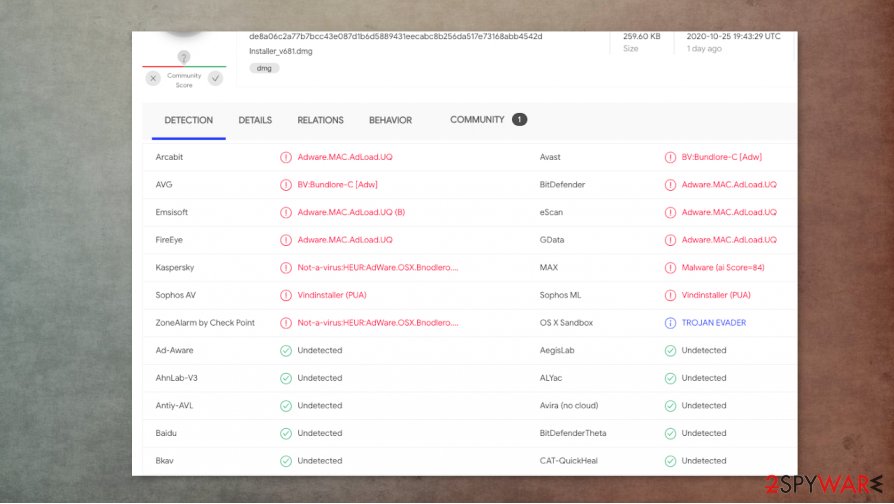Cyber Search (Easy Removal Guide) - Removal Instructions
Cyber Search Removal Guide
What is Cyber Search?
Cyber search – a browser hijacking extension that prevents itself from removal

Cyber search is a new browser hijacking extension that right after installation changes users' default search engine, homepage, and new tab to cybersearch.xyz, without the users' consent. In addition to that, it also enables the “Managed by your organization” option in Google Chrome and Safari browsers. This feature not only makes this potentially unwanted program (PUP) hard to get rid of, but it also collects sensitive information, such as browsing history and shares it with third parties.
Although most of the browser hijackers are distributed via software bundles, download managers, etc, Cyber search extension is administered via phony Adobe Flash player installer. You might get offered to install or update other Adobe products to, and PUP gets installed automatically.
By changing users' aforementioned browser setting, the developers of such PUP force hits to cybersearch.xyz, thus increasing its advertising revenue. Usually, these types of PUP display search results generated by other search engines. In this particular case, when using Safari browser, the results are shown from the webcrawler.com search engine whilst using Google Chrome browser – bing.com. This extension also interrupts users browsing by constant pop-up ads, random redirections to third-party sites.
| Name | Cyber Search |
| Type | Browser hijacker[1] |
| Distribution | Obtainable via fake Adobe Flash installers, can spread during insecure freeware installations |
| Symptoms |
Modified browser setting – start page, search engine, new tab Redirections to third party websites, intrusive ad display Inability to restore browser settings due to the enablement of “Managed by your organization” feature |
| Danger | User browsing details (searches, visited pages) are shared with third-parties |
| Removal | Use reliable anti-malware software to remove Cyber Search. How to restore browser settings read at the end of the article |
| System restore | Browser highjacks might infect not only the browser, but also the computers' registry. To completely restore your system, please use FortectIntego tool |
Even from the start page of cyberspace.xyz, you can smell that something fishy is going on. The page looks almost identical to google.com, just instead of the Google logo, you see a 'search' logo with the same coloring. And there are four pre-bookmarked buttons for you to push, all from big USA retailers.
Whilst this browser hijacker operates in the computer system, its users won't be able to use any other search engine, except the sponsored webcrawler.com and bing.com. The first search result for any inquiry will be some sort of ads, either eBay, Amazon, and so on. This is why Cyber Search is considered a PUP and can be detected[2] by AV tools.
Since this kind of application is used for affiliate marketing – users might not get what they expect when clicking on a provided link. Because of the redirections, people might end up on some scam, porn, or other mischievous sites. Experts[3] tend to note that the internet is filled with malicious pages, so Cyber Search redirects can expose you to some.
When victims of this Cyber Search virus try to remove it, they receive an error notification saying that the removal is impossible due to the fact that it's managed by the organization. If you're a home user and your computer system doesn't belong to an organization, please read below on how to delete this malware and restore the damage it might have done to your computer.

While the “Managed by your organization” feature is enabled on your Google Chrome browser, you won't be able to delete the Cyber Search hijacker or even cannot properly sync your browser data. You will have to make some changes to your computers registry that might be difficult. FortectIntego is a better tool for such corrupted settings.
But you still need to ensure that Cyber Search removal is completed. It might take time, so we recommend going for the more automatic options with anti-malware software and browser resetting techniques. Do not panic if you are not tech-savvy and follow the guide below.

Free distribution has its risks
You shouldn't rely on free sites that promote programs and claim about useful features that might not really mee those claims. Download sites and freeware distributors, torrent pages can be as harmful as those fake Adobe installers and updaters, pop-up scams. There are many issues that online content masks.
Make sure to rely on official sources when you download anything, especially when it comes to programs and software that get used on daily basis. Choose Advanced or Custom settings when you install programs and control applications that get downloaded on your device. Do not fall for those false update messages, and do not install extensions or apps from random pop-up ads.
Uninstallation of the program like this CyberSearch redirect requires help
You can try to remove Cyber Search yourself from the machine since this is a browser-based program that triggers all the issues on your web browser, but a proper cleaning process includes anti-malware tools and full system scans. Security tools can ensure that all the traces of the program and the main PUP – intruder that controls redirects get eliminated.
Cyber Search removal also should be taken seriously due to all the changes that users need to revert back to normal. Tools designed to alter the registry and other parts of the system settings can help you. If you want to do it yourself, try to:
- Open the Registry Editor.
- Then navigate to the directory using the left pane:
-
HKEY_LOCAL_MACHINE\SOFTWARE\Policies\Google\Chrome
- Remove the Extensions section.
- Eliminate all non-default entries.
- Close the Registry Editor and reset Chrome's settings to default.
You may remove virus damage with a help of FortectIntego. SpyHunter 5Combo Cleaner and Malwarebytes are recommended to detect potentially unwanted programs and viruses with all their files and registry entries that are related to them.
Getting rid of Cyber Search. Follow these steps
Uninstall from Windows
Instructions for Windows 10/8 machines:
- Enter Control Panel into Windows search box and hit Enter or click on the search result.
- Under Programs, select Uninstall a program.

- From the list, find the entry of the suspicious program.
- Right-click on the application and select Uninstall.
- If User Account Control shows up, click Yes.
- Wait till uninstallation process is complete and click OK.

If you are Windows 7/XP user, proceed with the following instructions:
- Click on Windows Start > Control Panel located on the right pane (if you are Windows XP user, click on Add/Remove Programs).
- In Control Panel, select Programs > Uninstall a program.

- Pick the unwanted application by clicking on it once.
- At the top, click Uninstall/Change.
- In the confirmation prompt, pick Yes.
- Click OK once the removal process is finished.
Delete from macOS
Remove items from Applications folder:
- From the menu bar, select Go > Applications.
- In the Applications folder, look for all related entries.
- Click on the app and drag it to Trash (or right-click and pick Move to Trash)

To fully remove an unwanted app, you need to access Application Support, LaunchAgents, and LaunchDaemons folders and delete relevant files:
- Select Go > Go to Folder.
- Enter /Library/Application Support and click Go or press Enter.
- In the Application Support folder, look for any dubious entries and then delete them.
- Now enter /Library/LaunchAgents and /Library/LaunchDaemons folders the same way and terminate all the related .plist files.

Remove from Microsoft Edge
Delete unwanted extensions from MS Edge:
- Select Menu (three horizontal dots at the top-right of the browser window) and pick Extensions.
- From the list, pick the extension and click on the Gear icon.
- Click on Uninstall at the bottom.

Clear cookies and other browser data:
- Click on the Menu (three horizontal dots at the top-right of the browser window) and select Privacy & security.
- Under Clear browsing data, pick Choose what to clear.
- Select everything (apart from passwords, although you might want to include Media licenses as well, if applicable) and click on Clear.

Restore new tab and homepage settings:
- Click the menu icon and choose Settings.
- Then find On startup section.
- Click Disable if you found any suspicious domain.
Reset MS Edge if the above steps did not work:
- Press on Ctrl + Shift + Esc to open Task Manager.
- Click on More details arrow at the bottom of the window.
- Select Details tab.
- Now scroll down and locate every entry with Microsoft Edge name in it. Right-click on each of them and select End Task to stop MS Edge from running.

If this solution failed to help you, you need to use an advanced Edge reset method. Note that you need to backup your data before proceeding.
- Find the following folder on your computer: C:\\Users\\%username%\\AppData\\Local\\Packages\\Microsoft.MicrosoftEdge_8wekyb3d8bbwe.
- Press Ctrl + A on your keyboard to select all folders.
- Right-click on them and pick Delete

- Now right-click on the Start button and pick Windows PowerShell (Admin).
- When the new window opens, copy and paste the following command, and then press Enter:
Get-AppXPackage -AllUsers -Name Microsoft.MicrosoftEdge | Foreach {Add-AppxPackage -DisableDevelopmentMode -Register “$($_.InstallLocation)\\AppXManifest.xml” -Verbose

Instructions for Chromium-based Edge
Delete extensions from MS Edge (Chromium):
- Open Edge and click select Settings > Extensions.
- Delete unwanted extensions by clicking Remove.

Clear cache and site data:
- Click on Menu and go to Settings.
- Select Privacy, search and services.
- Under Clear browsing data, pick Choose what to clear.
- Under Time range, pick All time.
- Select Clear now.

Reset Chromium-based MS Edge:
- Click on Menu and select Settings.
- On the left side, pick Reset settings.
- Select Restore settings to their default values.
- Confirm with Reset.

Remove from Mozilla Firefox (FF)
Remove dangerous extensions:
- Open Mozilla Firefox browser and click on the Menu (three horizontal lines at the top-right of the window).
- Select Add-ons.
- In here, select unwanted plugin and click Remove.

Reset the homepage:
- Click three horizontal lines at the top right corner to open the menu.
- Choose Options.
- Under Home options, enter your preferred site that will open every time you newly open the Mozilla Firefox.
Clear cookies and site data:
- Click Menu and pick Settings.
- Go to Privacy & Security section.
- Scroll down to locate Cookies and Site Data.
- Click on Clear Data…
- Select Cookies and Site Data, as well as Cached Web Content and press Clear.

Reset Mozilla Firefox
If clearing the browser as explained above did not help, reset Mozilla Firefox:
- Open Mozilla Firefox browser and click the Menu.
- Go to Help and then choose Troubleshooting Information.

- Under Give Firefox a tune up section, click on Refresh Firefox…
- Once the pop-up shows up, confirm the action by pressing on Refresh Firefox.

Remove from Google Chrome
Delete malicious extensions from Google Chrome:
- Open Google Chrome, click on the Menu (three vertical dots at the top-right corner) and select More tools > Extensions.
- In the newly opened window, you will see all the installed extensions. Uninstall all the suspicious plugins that might be related to the unwanted program by clicking Remove.

Clear cache and web data from Chrome:
- Click on Menu and pick Settings.
- Under Privacy and security, select Clear browsing data.
- Select Browsing history, Cookies and other site data, as well as Cached images and files.
- Click Clear data.

Change your homepage:
- Click menu and choose Settings.
- Look for a suspicious site in the On startup section.
- Click on Open a specific or set of pages and click on three dots to find the Remove option.
Reset Google Chrome:
If the previous methods did not help you, reset Google Chrome to eliminate all the unwanted components:
- Click on Menu and select Settings.
- In the Settings, scroll down and click Advanced.
- Scroll down and locate Reset and clean up section.
- Now click Restore settings to their original defaults.
- Confirm with Reset settings.

Delete from Safari
Remove unwanted extensions from Safari:
- Click Safari > Preferences…
- In the new window, pick Extensions.
- Select the unwanted extension and select Uninstall.

Clear cookies and other website data from Safari:
- Click Safari > Clear History…
- From the drop-down menu under Clear, pick all history.
- Confirm with Clear History.

Reset Safari if the above-mentioned steps did not help you:
- Click Safari > Preferences…
- Go to Advanced tab.
- Tick the Show Develop menu in menu bar.
- From the menu bar, click Develop, and then select Empty Caches.

After uninstalling this potentially unwanted program (PUP) and fixing each of your web browsers, we recommend you to scan your PC system with a reputable anti-spyware. This will help you to get rid of Cyber Search registry traces and will also identify related parasites or possible malware infections on your computer. For that you can use our top-rated malware remover: FortectIntego, SpyHunter 5Combo Cleaner or Malwarebytes.
How to prevent from getting browser hijacker
Access your website securely from any location
When you work on the domain, site, blog, or different project that requires constant management, content creation, or coding, you may need to connect to the server and content management service more often. The best solution for creating a tighter network could be a dedicated/fixed IP address.
If you make your IP address static and set to your device, you can connect to the CMS from any location and do not create any additional issues for the server or network manager that needs to monitor connections and activities. VPN software providers like Private Internet Access can help you with such settings and offer the option to control the online reputation and manage projects easily from any part of the world.
Recover files after data-affecting malware attacks
While much of the data can be accidentally deleted due to various reasons, malware is one of the main culprits that can cause loss of pictures, documents, videos, and other important files. More serious malware infections lead to significant data loss when your documents, system files, and images get encrypted. In particular, ransomware is is a type of malware that focuses on such functions, so your files become useless without an ability to access them.
Even though there is little to no possibility to recover after file-locking threats, some applications have features for data recovery in the system. In some cases, Data Recovery Pro can also help to recover at least some portion of your data after data-locking virus infection or general cyber infection.
- ^ Browser hiajcker. Wikipedia. The free encyclopedia.
- ^ Adware installer detection rate. VirusTotal. Online malware scanner.
- ^ Dieviren. Dieviren. Spyware related news.























